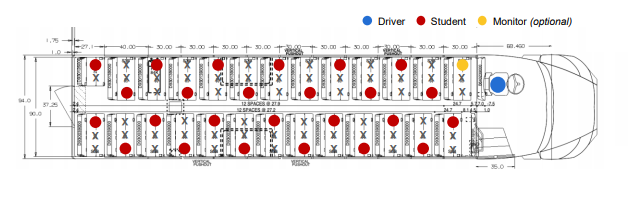Community
Massachusetts DESE issues guidance on student bus transportation for school year

The Massachusetts Department of Elementary and Secondary Education has issued a guidance on how schools can handle bus transportation for the upcoming school year.
The guidance is subject to change based on COVID-29 trends and medical research.
The DESE release stated the following guidelines that they feel will support safe school bus operations this fall.
• Masks
All staff and students on the bus, regardless of age, are required to wear masks at all 2 times. Exemptions for students due to medical and/or behavioral reasons – and associated protocols – are further described later in this guidance.
• Distance
Students should be seated no more than one student per bench, alternating sides for each row, which allows students to maintain approximately 3 feet of physical distance. Children from the same household may sit together and in closer proximity (e.g., two students per bench). Diagrams are provided later in this guidance.
• Ventilation
Keep windows open at all times during operation, unless not possible due to extreme weather conditions.
• Seat assignments
Students should be assigned to a single bus and a particular seat.
• Bus monitors
Districts should consider adding a bus monitor (e.g., volunteer, student leader, or staff member) for every bus to ensure strict adherence to these health and safety guidelines.
DESE issued the following recommended configuration for student seating on the bus.

According to DESE, assigning specific buses, routes, and seats to students and staff in advance will limit potential exposure and make contact tracing easier to conduct.
In addition, to prevent crowding and minimize interaction, students and transportation staff should follow the protocols outlined
below when entering or exiting the vehicle.
• Keep bus staffing assignments as static as possible by assigning drivers and other transportation staff to a single bus and a specific route.
• Assign students to a single bus and to an assigned seat. Children from the same household should be assigned seats together. Seating arrangements should also account for students with disabilities who require close contact from adults.
• As students board the bus, occupy seats starting from the rear of the bus and fill sequentially to the front. Upon arrival at school, the bus should be unloaded in a controlled manner, starting from the front of the bus and emptying sequentially to the back.
• Assign seats with the above boarding order and process in mind (i.e., based on when students will board during the route). For example, students boarding the bus at the beginning of the route should be assigned seats at the rear of the of the bus, and students boarding the bus at the end of the route should be assigned seats at the front.
Pick-up and drop-off protocols
• Consider having one bus of students enter the building at a time. When weather allows, students who are not entering right away should wait outside, preferably with members of their cohort, in designated areas that are clearly marked for physical distancing.
• Consider how to schedule students who will walk or bike to school or will be dropped off by car to limit crowding and support physical distancing.
• Prepare to respond to changing transportation patterns (e.g., more crossing guards, bike racks/storage)5 and work with local authorities as needed.
• Consider utilizing multiple entry/exit points and pick-up/drop-off locations (e.g., assign students/grade levels to different entrances at arrival and departure times).
• Modify protocols for parent/caregiver pick-up and drop-off
o Designate appropriate pick-up area(s) for parents/caregivers.
o Parents/caregivers should remain in their vehicle while waiting for their child.
o Parents/caregivers should maintain physical distancing standards and wear masks if they exit their vehicle.
• High schools should consider designating extra parking spots or street spaces for student parking if surveys show that more students will be using personal vehicles.
DESE stated that districts should look for ways to address bus capacity challenges by adding routes to existing bus runs, staggering start and end times for students, and encouraging families to seek alternative transportation to school when possible such as walking and biking programs.
-

 Community7 years ago
Community7 years agoNational Shrine of La Salette Festival of Lights 2017 set to begin
-

 Community6 years ago
Community6 years agoMassachusetts State Police looking for good home for retired dogs
-

 Crime6 years ago
Crime6 years agoFall River ranked most dangerous city in Massachusetts according to report
-

 latest7 years ago
latest7 years agoDurfee student allegedly overdoses on marijuana
-

 Community6 years ago
Community6 years agoVideo of Fall River Police goes viral
-

 Causes6 years ago
Causes6 years agoMissing Fall River woman found deceased
-

 Crime6 years ago
Crime6 years agoFall River Police add names to most wanted list
-

 Causes6 years ago
Causes6 years agoFall River teenager reported missing has been found




